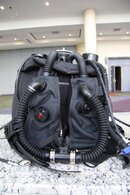This one lady that died in this incident was a diving instructor.
If she can't assemble the rebreather correctly, who can?
Unless she's a rebreather instructor, she may as well be a knitting instructor. But your point isn't wrong: even CCR instructors are not magically immune to human error, and the answer to your question is that statistically speaking
nobody will assemble a rebreather correctly 100% of the time.
Which is why we have and use build lists, closed checks, prejump checks, and in the water practices like bubble checks/6m O2 flushes/the occasional dil flush...all of which, when combined with a functioning human brain, let you figure out for yourself if the unit is working correctly. There are still things - like CO2 buildup, as apparently happened here - that we can't really check for. If you screw up a build in a way that creates that kind of fault, then there's an excellent chance you're going to die.
Which is why you think BOVs are some kind of obvious, 'should be mandatory' solution. And that's fine, so long as you confine the reach of your conclusion about whether the BOV's extra protection is worth its extra complications and risks
to your own damn diving. The rest of us have a different conclusion about whether design elements like a BOV are useful enough to merit inclusion.
As in all things, designing CCRs to negate all consequences of human stupidity is neither possible nor desirable. It's impossible because fools (and we all are, from time to time) are so ingenious. It's undesirable because while you'll save the occasional fool, the additional complexity will eventually lead to other fatal failures and the rest of us will have to deal with a machine designed for the lowest common denominator. And since we tend not to be an accepting, compliant lot, we'll instead mod units or go full home-brew. Having marketplace sufficiently lightly regulated that it allows for a wide variety of safety and design philosophies to compete is bound to work out better in the long run.
Which is not to say I don't appreciate and encourage simple, elegant design choices that reduce or eliminate risks of human error going undetected: I do, and like Potter Stewart, I know the right balance when I see it. I just don't get the 'everything I think is good should be mandatory, and everything I think is bad should be prohibited' philosophy.





 you up good.
you up good.